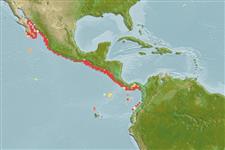Classification / Names
Common names from other countries
Main reference
Size / Weight / Age
Max length : 40.0 cm TL male/unsexed; (Ref. 1371); common length : 32.0 cm TL male/unsexed; (Ref. 1371)
Length at first maturity
Lm 22.0, range 18 - 27 cm
Environment
Marine; demersal; non-migratory; depth range 80 - 523 m (Ref. 58018)
Climate / Range
Subtropical, preferred 23°C (Ref. 107945); 28°N - 1°N, 113°W - 78°W (Ref. 58452)
Distribution
Eastern Pacific: off the west coast of the Americas from Del Mar, California to Ensenada de Tumaco, Colombia. Vrooman and Paloma's (1970) dwarf hake off the coast of Baja California has recently been described as a different species, Merluccius hernandezi Mathews, 1985.
Countries | FAO areas | Ecosystems | Occurrences | Introductions
Short description
Dorsal
spines
(total): 1;
Dorsal
soft rays
(total): 45-52. Head rather long, about 30% of SL. Gill rakers long and slender, with pointed tips. Pectoral fins long, the tips reaching to or beyond the origin of the anal fin. Overall color silvery, lighter ventrally.
IUCN Red List Status (Ref. 115185)
Threat to humans
Harmless
Human uses
Fisheries: minor commercial
More information
Age/SizeGrowthLength-weightLength-lengthLength-frequenciesMorphometricsMorphologyLarvaeLarval dynamicsRecruitmentAbundance
ReferencesAquacultureAquaculture profileStrainsGeneticsAllele frequenciesHeritabilityDiseasesProcessingMass conversion
Tools
Special reports
Download XML
Internet sources
Estimates of some properties based on models
Phylogenetic diversity index
PD50 = 0.5000 many relatives (e.g. carps) 0.5 - 2.0 few relatives (e.g. lungfishes)
Trophic Level
4.0 ±0.5 se; Based on size and trophs of closest relatives
Resilience
Medium, minimum population doubling time 1.4 - 4.4 years (K=0.34-0.35; tm=3; tmax=7)
Vulnerability
Low to moderate vulnerability (33 of 100)
Price category
